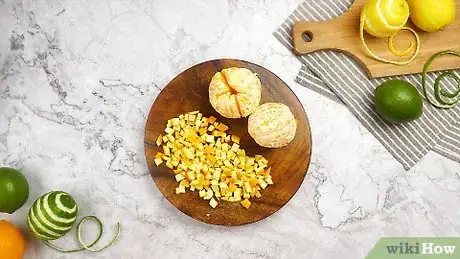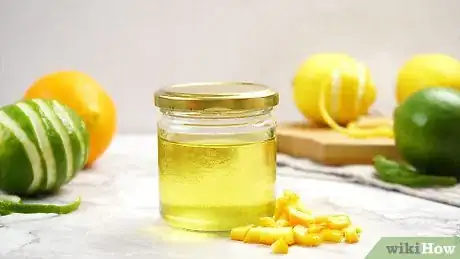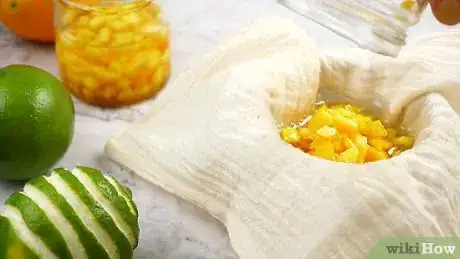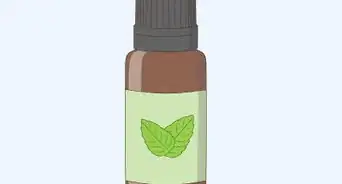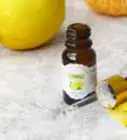This article was co-authored by wikiHow Staff. Our trained team of editors and researchers validate articles for accuracy and comprehensiveness. wikiHow's Content Management Team carefully monitors the work from our editorial staff to ensure that each article is backed by trusted research and meets our high quality standards.
This article has been viewed 70,288 times.
Learn more...
Scented oils are an easy way to combat less pleasant smells around your home. You can leave an open jar in front of a fan to improve the air in a whole room, or you can simply drop a couple of drips into your smelly sneakers, ashtrays, or toilet. They're also incredibly easy to make yourself. All you need is a little patience and any fruit with a rind!
Ingredients
- ½ cup cooking oil
- Vitamin E (liquid)
- ¼ cup chopped fruit rind: blood orange, clementine, grapefruit, kumquat, lemon, lime, tangerine, or yuzu
Steps
Making Oil in a Few Hours
-
1Prep your fruit. Clean it thoroughly before peeling. Wash your hands and then use your fingers to scrub the fruit under running water. Get rid of any lingering chemicals or dirt. Then peel the skin and roughly chop the peel.
-
2Simmer your ingredients. Pour your oil into a pot. Add your fruit peel.[1] Also add two drops of vitamin E, which will preserve your oil.[2] Stir the ingredients together. Place the pot on the stovetop and set the burner to low heat. Allow the mixture to simmer for anywhere from five minutes to eight hours.Advertisement
-
3Strain and store your oil. Line a small strainer with cheesecloth. Set the jar in the sink in case you spill any oil. Place the strainer on top and then pour the oil from the pot into the strainer. Label the jar with today’s date. Seal any oil that isn’t used right away and store it anywhere that stays cool and dark. Expect your oil to last six months if stored properly.[3]
Using the Stove to Make Oil More Slowly
-
1Warm your jar in boiling water. Place a pot on your stovetop and your jar inside the pot. Fill the pot with enough water to cover most of the jar, but not enough for it to spill inside. Bring the water to the boil. Let the jar sit in boiling water for about ten minutes so it warms up.[6]
-
2Add your ingredients to the jar. Transfer your chopped fruit peel to the jar. Then pour the oil in. Use a jar that is narrow enough for the oil to completely cover the fruit peel.[7] For a preservative, add two drops of vitamin E.[8] Then let the filled jar continue to sit in boiling water for an additional ten minutes.
- To avoid scalding your hands as you fill the jar, either remove it with tongs or turn the heat off so the water quits bubbling.
-
3Let the fruit peel soak. After ten minutes in boiling water, use tongs to remove the jar from the pot. Transfer the jar to an area that receives sunlight. Let it sit there for a couple days. Allow the almond oil some time to extract the fruit essence.[9]
-
4Test its strength and repeat, if needed. Line a strainer with cheesecloth and place the strainer over another container. Pour the liquid from the jar into the strainer. Smell the liquid to gauge the strength of the scent. For a stronger scent, pour the liquid back into the jar and add a fresh ¼ cup of chopped fruit peel to the oil. Give it another couple of days before testing again.[10]
- Continue to repeat as desired until the scent matches your preferences.
Making Oil without a Stove
-
1Soak your ingredients. Drop your fruit peel inside. Pour the oil on top. Use a jar that is narrow enough for the oil to completely cover the fruit peel.[11]
-
2Set the jar in sunlight. Place it anywhere that will receive plenty of light over the course of the day. Use the sunlight to warm the oil and begin extracting the fruit's essence. Give it one or two days to do so.
-
3Test its strength and repeat if necessary. First, line a strainer with cheesecloth and place the strainer over another container. Pour the jar’s contents into the strainer. Sniff the liquid to judge the strength of its scent. If desired, add a fresh ¼ cup of fruit peel to the jar and pour the liquid back in to soak for another day or two.[12]
- Repeat as desired up to a half-dozen times.
Things You’ll Need
- Small, sealable jar and lid
- Strainer
- Cheesecloth
- Label
- Pot (optional)
- Stove (optional)
References
- ↑ http://www.epicurious.com/archive/holidays/hanukkah/flavored-oils
- ↑ http://www.livestrong.com/article/133448-how-make-your-own-essential-oils/
- ↑ http://www.livestrong.com/article/133448-how-make-your-own-essential-oils/
- ↑ http://www.ebay.com/gds/How-to-Make-Your-Own-Fragrance-Oils-/10000000178723093/g.html
- ↑ http://www.epicurious.com/archive/holidays/hanukkah/flavored-oils
- ↑ http://www.ebay.com/gds/How-to-Make-Your-Own-Fragrance-Oils-/10000000178723093/g.html
- ↑ http://www.ebay.com/gds/How-to-Make-Your-Own-Fragrance-Oils-/10000000178723093/g.html
- ↑ http://www.livestrong.com/article/133448-how-make-your-own-essential-oils/
- ↑ http://www.ebay.com/gds/How-to-Make-Your-Own-Fragrance-Oils-/10000000178723093/g.html
